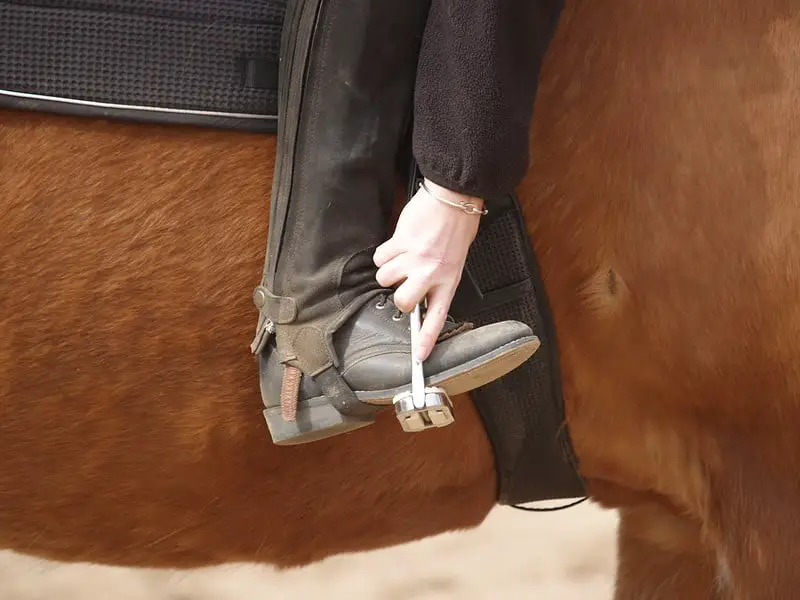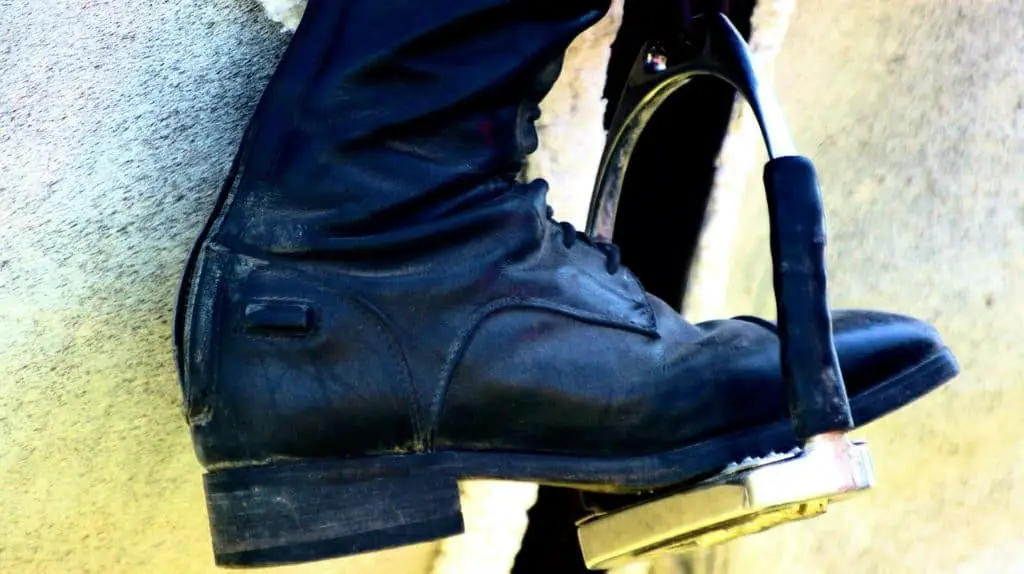As someone with bad knees, I often find myself quite a bit sore after a long ride. This leads me to wonder if my stirrups were the cause of my pain. There had to be something out there that can help me with this issue. I decided to go ahead and do some research to find out.
Unfortunately the answer to the question, “what are the best stirrups bad knees?” is that it depends. Every rider is going to be different but we can do just talk about what causes the pain and what to look for stirrup that might help you.
What causes knee pain?
Personally, I believe that my knee pain comes from years hitting the slopes while I grew up in the Black Hills of South Dakota. Whatever the cause I know that a good long trail ride will leave me sore for at least a day or two.
So you might be asking yourself, what causes knee pain after a ride? According to The Mayo Clinic, knee pain caused by a wide variety of issues. These include an ACL injury, fractures, torn meniscus, knee bursitis, patellar tendonitis, loose bone fragments, over 100 forms of arthritis, or Patellofemoral pain syndrome.
What this means is that there are literally hundreds of reasons that you could be experiencing knee pain. When in doubt you should talk to your doctor.

We often put our bodies through tons of activities that we just were not designed for. When we go horseback riding we definitely fall into that category.
Let’s think about it for a minute. When we are riding we are spreading our hips are wider normally would walking around. This causes our knees to be turned outward. Go ahead and try it. Additionally, we put our feet into the stirrups which is trying to force our knees inward a small amount.
Therefore the top of our knee wants to go one direction and the bottom wants to travel in another. In fact, it is this contradictory force that helps us stay on the horse by providing friction both in our thighs and shins as we force our legs to follow the curvature of the animal.
As one way to resolve this, we can try to use a different pair of stirrups to allow our ankles to turn in a more natural way. This can, in turn, relieve some of the forces acting on our knees. This is because everything is connected. 🎵 “the ankle bone is connected to the… Shinbone. The shinbone is connected to the knee bone.”
Is my stirrup the problem?
Actually Yes as we mentioned above, it could be if they push your body further in ways that cause discomfort. However, one additional thing to check is that your stirrups are properly adjusted. If they are too short they will increase discomfort dramatically, too long and they aren’t exactly doing their job.
There are a couple of quick ways to check and see if your stirrups are adjusted correctly for a western saddle. Once you are seated as you normally would, let your feet and legs hang down. The stirrups should be directly in line with your ankle bones. Then another trick to checking your length, put your feet into the stirrups and stand up, there should be a small gap between the saddle and your… err… privates. You should be able to fit your hand in between the two.
What Stirrups could help me?

What we are looking for are stirrups that improve the ergonomics of your knees. You want them to allow your ankles a freezer range of motion. That motion, in turn, is going to help relieve knee pain.
Unfortunately, each person is going to have a different preference for what stirrup is best for them and their own knees. Some of this comes down to each individual’s previous knee injury while other times it just comes down to the makeup of each person’s bone structure.
To make things worse, most stirrups designed to alleviate knee pain are also very expensive. For example, last I checked Don Orrel stirrups cost about one hundred sixty dollars. For many of us, that price point is a bit hard to swallow. This is especially true when we can use the same stirrups we already own with a stirrup corrector that can be found for as little as forty dollars.
What about Don Orrel could be worth such a difference? To be honest, I have not purchased them for myself so I’m not exactly the person to give an in-depth review on them. According to their website, they have spent time perfecting the angle at which your footrests. This time spent on the angles helps to reduce the stress and strain on your ankle. As we mentioned earlier everything we do to our ankles, in turn, affects our knees as they are all connected.
Stirrup options for knee pain

Whether or not you are a Western or English rider both have the option to add a stirrup wrap to their existing stirrups. Many riders I’ve talked to with similar knee problems have found these to be a great help. The idea is to provide some level of shock absorption. Additionally, the wrap provides additional stability by providing a bit of extra width as well as some “stickiness.”
Another option for western riders is a stirrup turner. These turn the stirrups a full 90 degrees. Again this is not something that I have personally used, however, many riders claim that these simple, and cheap accessories have almost completely relieved their knee pain. One of the most recommended ones I was able to find was the Tough 1 Stirrup Turners On Amazon. With these, you will need to adjust your stirrup length afterward in order to get the full effect as they add quite a few inches of length.
English riders seem to have more options as far as a knee support. One of the most talked-about options is Flexi stirrups. These stirrups are designed to flex at the base, this allows your feet to not be as forced into angles that cause your knee pain. They also have English stirrups with built-in shocks to provide added cushion for your knees and ankles while riding. Amazon has these available that allow for both flex and shock absorption from what I hear they are awesome!
Another highly recommended solution for English riders is the free jump stirrups. These hi-tech stirrups are designed with a single branch made of spring steel that allows some shock absorption as well as an enlarged footbed. Again the idea here is to relieve pressure on the ankles and in turn knee pressure.
What about riding bareback?
Since stirrups seem to be the cause of our knee pain, you may be thinking to yourself “Why use them at all?” If you happen to be a skilled enough rider this is actually a fantastic way to go about solving your knee problem. If you are new to riding I would recommend that you start very slowly. Riding bareback is a learned skill that can take a long time to get really good at. Riding bareback the first time will be a great relief from knee pressure; but, I can say firsthand that your thighs will be sore in ways you’ve never experienced.
In summary, you have a wide variety of solutions that could work for you as a rider whether you are an English rider or a Western rider. Unfortunately, these options are widely up to the personal preferences of the rider.
